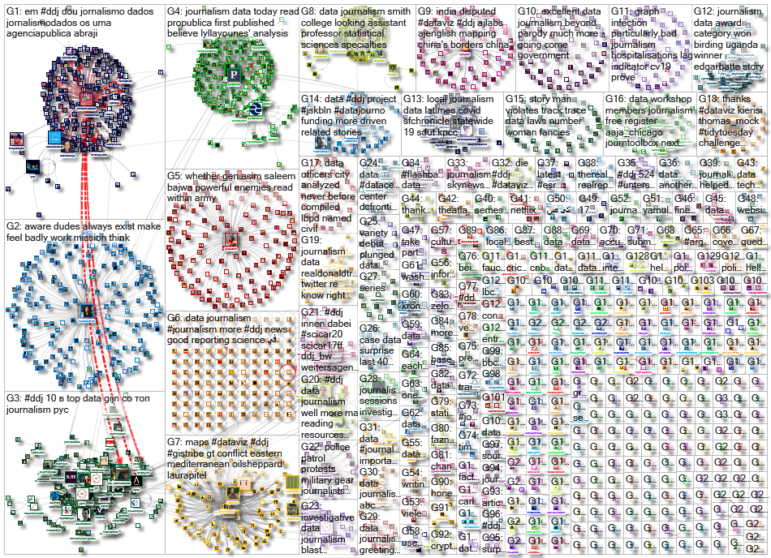Territorial disputes — over land, borders, or resources — are a long-standing source of tension around the world. Our NodeXL #ddj mapping from September 7 to 13 finds Al Jazeera explaining the India-China dispute over a shared Himalayan border in seven maps, and the Financial Times attempting to put into context the tensions between Turkey and its neighbors competing over natural gas discoveries. We also find Stanford University and Big Local News offering data reporting grants on the pandemic, and other groups offering free data journalism workshops and webinars.
Mapping India and China’s Disputed Borders
After a military standoff between India and China along the long-disputed Himalayan border — which spans 3,440 kilometres — the two countries have agreed to disengage their troops. Al Jazeera attempted to explain the border row using seven interactive maps. Journalist Mohammed Haddad summarizes the story and shares the tools he used to create the project in this tweet thread.
A fabulous interactive piece from @ajlabs @haddadme @msaifkhalid. Do see, it's worth your time.https://t.co/IwzT0F996a
— Vijay Srinivas (@vijay_srinivas2) September 10, 2020
A Dash for Gas in the Mediterranean
Competition over natural gas discoveries in the eastern Mediterranean has fueled tensions between Turkey and its neighbors in recent months. The Financial Times illustrates the ongoing conflict in a (paywalled) explainer. You can watch a summary of the conflict in this free-to-watch video here.
Countries in the eastern Mediterranean have reached such a tense point over gas discoveries in the sea that many experts are now talking about a possible war. Here is why this is happening 👇 https://t.co/e1wcMTpMlP pic.twitter.com/uPrt2haecW
— Financial Times (@FinancialTimes) September 8, 2020
Fact-Checking an Evacuation
Authorities in Oregon state, on the US West Coast, estimated that 500,000 people had been evacuated from their homes as a result of wildfires. The astounding number sparked scary headlines at major national news outlets. However, local daily newspaper The Oregonian/OregonLive realized that the numbers didn’t add up and challenged the state’s count, and the authorities later greatly reduced their estimates.
Update: Oregon state officials now say that only 40,000 residents have been told to evacuate b/c of wildfires.
They had previously said it was 500,000, a figure that was plastered across national news media for hours.
Off by 460,000 people. ¯_(ツ)_/¯https://t.co/kavbH5isQq
— Shane D. Kavanaugh (@shanedkavanaugh) September 11, 2020
Investigating Government Contracts
Peruvian nonprofit newsroom Ojo Público has created a tool to investigate government contracts — called FUNES — which won first place in the innovation category of the Sigma Awards for data journalism. Open Contracting Partnership published a behind-the-scenes look at the creation and development of the tool, dubbed “an algorithm to fight corruption.”
A look behind the scenes of @Ojo_Publico's procurement monitoring tool FUNES: an algorithm analyzing red flags in more than 245,000 public contracts by @colmanromi https://t.co/ozkxFt6rnV pic.twitter.com/qQRvuCJAAS
— Georg Neumann (@georg_neu) September 10, 2020
COVID-19 Deaths in Polluted Areas
Could residents breathing polluted air suffer more serious consequences from the coronavirus? According to peer-reviewed research by ProPublica and the State University of New York’s College of Environmental Science and Forestry, COVID-19 can become more severe — and, in some cases, more deadly — by industrial emissions called hazardous air pollutants, or HAPs. The team examined air pollution and coronavirus deaths in roughly 3,100 counties across the US and found a close correlation between levels of hazardous pollutants and per capita death rate from COVID-19.
“We knew that what we had been fighting all these years was only going to make us more susceptible to COVID mortality,” said Mychal Johnson, an organizer in the South Bronx. He may have been right. Read the story: https://t.co/1vMKqMU9Dl
— Lylla Younes (@lyllayounes) September 11, 2020
COVID-19 Surges in India
India has now overtaken Brazil to become the country with the world’s second highest number of coronavirus infections, behind only the US. The nation has been adding roughly 90,000 new cases every day as it eases lockdown measures in an effort to revive its battered economy. The Financial Times mapped India’s daily number of COVID-19 cases by state (paywalled).
India now has the second highest number of #COVID19 cases, surpassing Brazil. Awesome graphics by @digitalcampbell in this fascinating article by @AmyKazmin and @jyots43 on how the virus has spread to more rural parts of Indiahttps://t.co/JvfPsFJ7Om#gistribe #dataviz #ddj pic.twitter.com/UCvUxEDtEI
— Steven Bernard (@sdbernard) September 8, 2020
Answering Voters Queries
With just seven weeks to go until the US election, NBC News created an interactive, and easily understandable map, to answer four essential questions for voters. It includes details on mail-in and early in-person voting, as well as the first day voters can cast their ballot.
NEW: With so much misinfo about mail-in voting, and general confusion on voting rules, @NBCNews is launching this excellent new public service with interactive guides on how and when you can vote in each state. https://t.co/Gv0n4CUdxU #PlanYourVote
— Micah Grimes (@MicahGrimes) August 17, 2020
Pandemic Data Reporting Grants
Looking for funding for data journalism projects related to COVID-19? The John S. Knight Journalism Fellowships at Stanford University and Big Local News, a project of the Stanford Journalism and Democracy Initiative, are offering grants for data-driven, replicable stories tied to the pandemic. Selected projects will receive funding to cover the costs of data collection, analysis, and reporting, and the grants are open to journalists worldwide.
Are you or your newsroom working on a #ddj project related to the coronavirus pandemic? Could it be replicated elsewhere? If so, funding for your project may be available! Learn more about this unique grant opportunity. #jskbln #datajourno https://t.co/4Qv4jkUnWc
— John S. Knight Journalism Fellowships at Stanford (@JSKstanford) September 10, 2020
Tracking Cutbacks in US Newsrooms
For the past six months, the Tow Center for Digital Journalism has been collecting and vetting information on furloughs, layoffs, pay cuts, and other cutbacks happening in newsrooms across the US during the coronavirus pandemic. Now, they’ve released the data — which paints a depressing picture of an industry under extreme pressure — in a searchable map, categorizing the data by outlet, owner, and type of cutback.
This vital and disheartening tracker from @kristenhare, @TowCenter, @beteprown @__gabbymiller shows US newsroom cutbacks that have occurred during the COVID-19 pandemic.
We need journalism more than ever.
But journalism also needs us more than ever. https://t.co/nXv7wqMlfd
— Alice Li (@byaliceli) September 9, 2020
Free Data Journalism Workshops
The Chicago chapter of the Asian American Journalists Association is offering a free online workshop on data journalism. Learn how to build interactive graphics and maps, scrape data with Google Sheets, and craft data pitches based on your beat from instructors Mike Reilley and Jasmine Mithani. Also, check out a free webinar by the Rainforest Journalism Fund and the Pulitzer Center on using data for investigative journalism in the Congo Basin. And if you missed the earlier online course “Equity & ethics in data journalism” from the Knight Center for Journalism in the Americas, it’s now available as a free, self-directed class.
NEXT THURSDAY: Join @AAJA_Chicago for an online workshop on data journalism, featuring local journalists @journtoolbox and @jazzmyth! FREE for members and non-members.✨
Register here: https://t.co/9YGZJopnp8 pic.twitter.com/1a58oBnn1r
— AAJA Chicago (@AAJA_Chicago) September 10, 2020
Thanks again to Marc Smith and Harald Meier of Connected Action for gathering the links and graphing them. The Top Ten #ddj list is curated weekly.
 Eunice Au is GIJN’s program manager. Previously, she was a Malaysia correspondent for Singapore’s The Straits Times, and a journalist at the New Straits Times. She has also written for The Sun, Malaysian Today, and Madam Chair.
Eunice Au is GIJN’s program manager. Previously, she was a Malaysia correspondent for Singapore’s The Straits Times, and a journalist at the New Straits Times. She has also written for The Sun, Malaysian Today, and Madam Chair.

